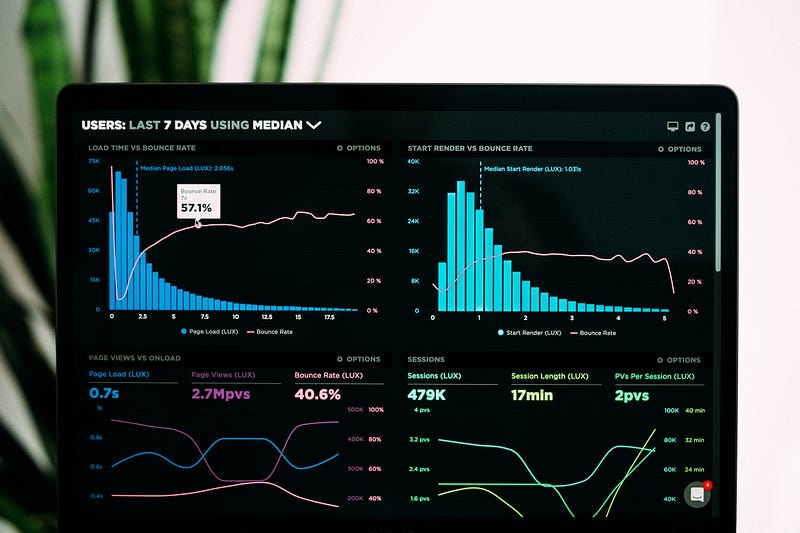Harnessing Your Mind’s Potential for Maximum Productivity
Written on
Understanding Your Mind’s Role in Productivity
Have you ever considered that merely 26% of individuals regularly leave work feeling accomplished? This alarming statistic reflects a common struggle many of us face. We often start each day with the intention of maximizing our time, yet we frequently find ourselves distracted, disengaged, or overwhelmed, leading to minimal progress.
So, what’s the root of this issue? It often stems from the way our minds are conditioned to handle tasks. After experiencing the frustrating cycle of enthusiasm for a project followed by apathy, I knew I had to make a change.
In my journey to enhance myself, ultimately to establish my online business and achieve my ideal life, I delved into various strategies and techniques aimed at unlocking my full potential. My goal was to remain consistently focused and motivated while achieving peak productivity.
I want to share my findings with you, providing a comprehensive guide to scientifically-supported methods and psychological tools that can supercharge your productivity. We’ll explore everything from foundational psychology and the importance of routine to cognitive techniques and digital tools designed to keep you on track.
Forget aimless browsing through generic productivity advice; by continuing to read, you will gain actionable strategies that go beyond surface-level tips. You’re on the brink of significant change, so let’s dive in!

Understanding the Connection Between Mind and Productivity
You might be motivated and ready to turn your intentions into reality, yet find yourself stumbling. What causes this disconnect? To answer that, we need to examine the psychology of productivity.
Your mind functions as a finely-tuned machine when it comes to productivity. Neurotransmitters like dopamine and adrenaline enhance your alertness and focus, preparing you to tackle tasks. However, it's not always that simple.
It’s more than just having a meticulously organized schedule or a suite of time-saving applications. Often, our minds create barriers. Limiting beliefs—such as “I’m not capable” or “This task is beyond me”—and cognitive hurdles like procrastination or fear of failure can stifle even the most fervent motivation.
Once you identify these mental obstacles, the next step is to confront them. Take a moment to write down any beliefs you think may be hindering your productivity.
Do you hesitate when faced with large projects? Are you paralyzed by the fear of failing? Documenting these thoughts is essential to dismantling the mental barriers you've constructed.
Gaining insight into the link between your mindset and productivity is key. It’s not merely about doing more; it’s about learning how to optimize your mental resources for smarter work.
Let’s continue exploring the foundational elements that set the stage for a productivity transformation by engaging your actions, thoughts, and emotions.

The Fundamentals of Peak Productivity
Now that you've begun to recognize those troublesome mental barriers, you're on the right track! Understanding the issue is just the first step; we need to establish a strong foundation for effective action.
Let’s start with mindfulness and focus. Mindfulness isn’t merely a trendy buzzword; it’s a crucial element of productivity. When you practice mindfulness, you are wholly present in your tasks.
Instead of getting lost in thoughts about dinner plans or reliving last week’s embarrassing moment, you are focused and committed to the current task. This level of concentration allows you to accomplish tasks swiftly and effectively.
Next, let’s discuss the significance of routines and habits. Why are morning rituals or evening wind-downs so effective? Our brains thrive on patterns.
You can program habits and routines into your day to serve as mini productivity boosts, minimizing decision fatigue and allowing you to channel your energy into areas that require your full attention.
What’s the next logical step? Crafting a routine that aligns with your personal productivity strengths! Start by listing daily tasks. Identify those that can be automated or grouped together, and assign specific time slots for more demanding tasks that need your undivided attention.
Experiment with this for a week to see what feels natural and effective. Soon, you’ll have a personalized routine that enhances your productivity. With these foundations established, you’re poised to explore psychological techniques that can provide that extra push.

Psychological Techniques to Boost Productivity
With a solid grasp of mindfulness and routine, let’s elevate your productivity with psychological techniques that can enhance your performance.
Cognitive Behavioral Techniques (CBT) are invaluable tools in this regard. CBT focuses on altering dysfunctional thoughts and behaviors, essentially reprogramming your brain to align with your goals rather than working against them.
Rather than doubting your capabilities, you can redirect that energy into productive action.
Additionally, let’s explore Neuro-linguistic Programming (NLP). If CBT is like engaging in a thoughtful dialogue with your mind, think of NLP as the quick, impactful phrases that drive straight to the point. Techniques like the ‘Swish Pattern’ in NLP can replace unproductive habits—like mindless social media scrolling—with more beneficial activities, such as diving into that report you need to complete.
Numerous studies and discussions have been dedicated to CBT and NLP, and a single article can only touch the surface.
So how can you transition from mere knowledge of these techniques to applying them? Here’s a simple exercise to help you begin.
Identify one small, annoying task you’ve been avoiding. Use the CBT technique to confront the limiting thoughts surrounding it. For instance, “I don’t have time” can be reframed as “I can take small steps.”
For NLP, visualize replacing the time spent on distracting habits with this task. This is when you can observe those negative thought patterns or triggers you’ve identified.
These steps become actionable once you’ve documented your thoughts, as discussed earlier. Try this for a week and observe the impact on your productivity.
These techniques can be beneficial not only for work-related tasks but can also enhance various aspects of your life. Next, let’s focus on the importance of goal-setting and how crafting the right goals can significantly influence your success.

The Impact of Goal-Setting
Now that you’ve gained insights into your mind, established routines, and experimented with psychological strategies, let’s channel that newfound knowledge into effective goal-setting. Enter the SMART framework—Specific, Measurable, Achievable, Relevant, and Time-bound goals.
This approach is more than just another acronym to remember; it’s a practical method that works.
Vague goals, like “I want to be more productive,” often get lost in the hustle of daily life. SMART goals keep you anchored and focused.
For example, stating, “I will complete two hours of uninterrupted work each morning for a week” is specific, measurable, achievable, relevant, and time-bound. Its clarity makes it easier to align your actions accordingly.
How do we convert theory into tangible outcomes using this framework? Grab a piece of paper and write down a goal you’ve been considering. Apply the SMART criteria to it.
Ask yourself: Is it specific enough? Can I track my progress? Is it feasible with my current resources? Is it aligned with my larger objectives? Have I established a deadline?
This exercise not only clarifies your goal but also provides a roadmap for achieving it. As you refine your goals, decision-making and task prioritization will become more intuitive, especially with the mindfulness, routines, and psychological techniques you’ve learned.

Leveraging Technology for Better Productivity
Let’s shift our focus to the digital realm. Time management applications can serve as the virtual assistants you never knew you needed. Tools like Todoist for task management or Focus Booster for implementing the Pomodoro Technique can significantly enhance your daily workflow.
These apps help you track tasks, prioritize effectively, and even remind you to take breaks or shift to the next item on your to-do list.
However, isn’t excessive screen time detrimental? Yes, and this leads us to the concept of a digital detox. Reducing screen time doesn’t mean abandoning your productivity apps; it means making more informed choices.
Limit social media distractions, disable non-essential notifications, and establish app limits to create a mindful digital space. This will free up time and refresh your mental state, allowing you to tackle your tasks with renewed vigor.
How can you achieve a balance between using technology for productivity and avoiding digital burnout? Start by auditing your device.
Review the apps and notifications currently enabled. Which ones contribute to your productivity goals? Which ones are merely distractions? Take action based on this evaluation—delete or limit distracting apps while prioritizing those that align with your productivity needs.
With these tech tools and strategies, you’re adding another layer to your growing productivity toolkit. Remember, tools are most effective when integrated into a broader strategy, just like the other methods we’ve discussed.

Monitoring and Adapting for Continued Success
At this point, you’ve gathered an impressive collection of psychological insights, tech hacks, and goal-setting strategies that would impress any productivity expert.
However, these strategies only become impactful when practiced consistently and transformed into habits. This is where the monitoring and adjusting phase becomes crucial.
Reflecting on your methods is akin to having your GPS recalibrate your route, ensuring you’re still on the fastest path to your destination.
Whether through daily journaling or a simple checklist, taking stock can highlight what’s effective and what isn’t.
What should you do when you encounter a roadblock or discover that a technique isn’t delivering the expected results? Pivot. Modify your strategy. Don't discard everything you’ve learned.
Perhaps your morning routine needs to be shortened, or your SMART goals need to be more realistic. It’s perfectly acceptable to make adjustments, as rigidity can be just as counterproductive as a lack of planning.
How can you incorporate this recalibration into your workflow? Consider instituting a weekly review. Dedicate 20 minutes at the end of each week to assess your goals, accomplishments, and obstacles encountered.
Rate your productivity methods on a scale of 1 to 5; anything below a 3 might require reevaluation. This quick yet effective ritual can help you avoid prolonged periods of unproductivity in the future.
With these insights, you now possess a well-rounded strategy that can endure over time. The beauty of this approach lies in its adaptability; you can adjust, test, and refine to meet your evolving life and priorities.

Conclusion: Taking Action
We’ve explored the intricate relationship between your mindset and productivity, established essential foundations like mindfulness and routine, experimented with psychological techniques, and even integrated tech tools and hacks. We’ve emphasized the importance of setting goals and the need for ongoing assessment and adaptation of strategies.
It’s a lot to absorb, but the key lies in taking action and applying this newfound knowledge effectively.
Start small if necessary—choose one or two strategies and begin incorporating them into your routine today. Remember, the ultimate aim is not to increase busyness but to ensure that every action you take is meaningful and effective.
Whether you adopt a new morning routine or set smarter goals, every small change contributes to your desired future.
Your turn! What has worked for you in the past? What strategies are you eager to try? I invite you to share your productivity tips or success stories in the comments below.
Your insights could be the missing piece in someone else’s productivity puzzle. Let’s foster a community where we support one another in our journeys toward greater efficiency and focus.
Cheers to a future where you are more productive and engaged than ever before!
Do you agree or disagree with any of my ideas? Please share your thoughts in the comments below; I always appreciate hearing different perspectives.
Thank you for reading to the end! If you found this valuable, consider subscribing.
Explore techniques to rewire your brain for enhanced productivity and learn how to stay more focused in your daily tasks.
Discover how to unlock your mind's potential and achieve your goals with insights from Tony Robbins in this inspiring video.